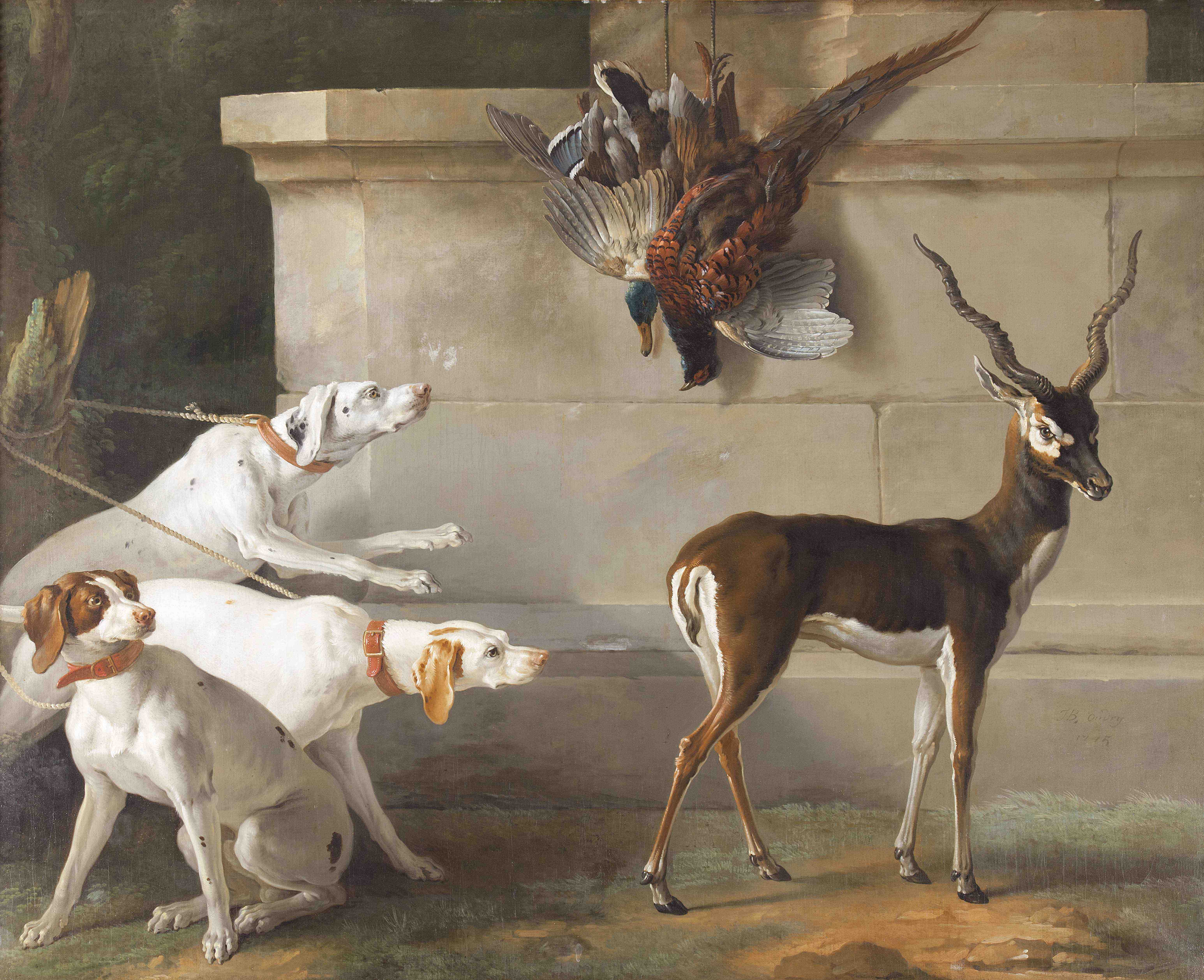
Indian Blackbuck with Three Pointers
Jean-Baptiste Oudry(1686-1755), 1745
Jean-Baptiste Oudry (1686 –1755) was Painter-in-Ordinary of the Royal Hunt in the court of King Louis XV of France. The artist is best known for his exceptional still-life works and his skill in depicting animals. A painter and professor at the Royal Academy, Oudry was the foremost decorative painter of his day in France and Germany. His highly finished, naturalistic approach won him a reputation as the greatest animal painter of his time.
In this painting, three pointers, rendered in exquisite shades of white and grey, strain at the leash while a noble blackbuck stands just out of reach. The deer in its stillness is unperturbed, projecting an air of quiet dignity.
This painting is considered one of the finest in the Beit collection and was acquired by Alfred Beit for the Entrance Hall at Russborough in 1961. At almost two metres in height, this life-size work has wonderful impact.
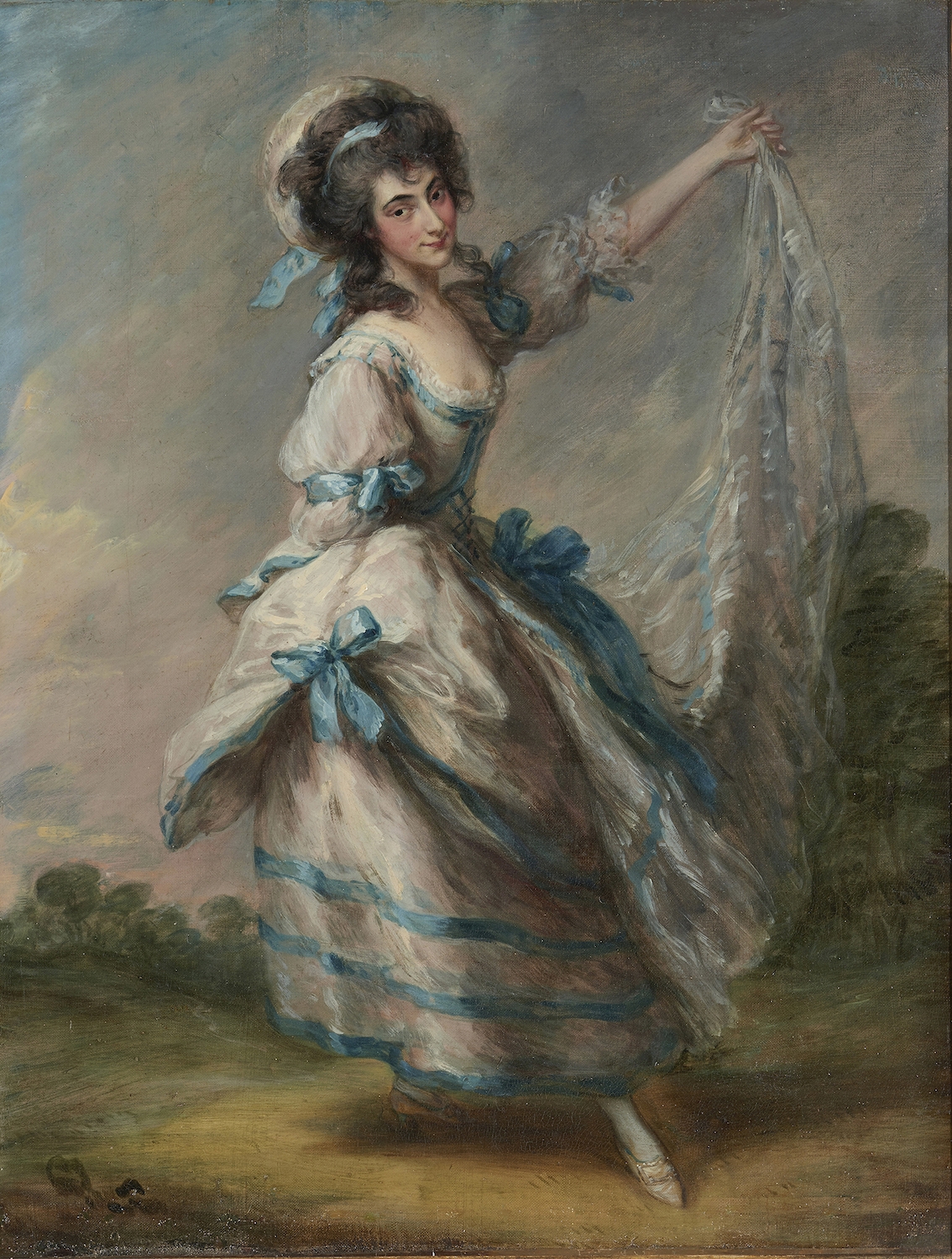
Madame Bacelli
Thomas Gainsborough (1727-1788), Circa 1781
This lively sketch of Venetian dancer Giovanna Bacelli, depicted in costume, make-up and pose from Louis Simonet’s ballet, Les Amans Surpris, is a favourite with visitors to Russborough. Bacelli was a principal ballerina in London at the King's Theatre, Haymarket. She was also the mistress of John Frederick Sackville, 3rd Duke of Dorset.
Painted in 1785 the sketch is typical of Gainsborough's masterful late style and here his quick, light brushwork combined with the delicate tones imbues the painting with a palpable sense of movement and ‘an ethereal loveliness such as only Gainsborough could achieve’ (Wilhelm von Bode, 1904).
Measuring just 57 x 48 cm, the full-size companion portrait, painted for Sackville, is now in the collection of Tate Britain.
Russborough's painting was bought at a Thomas Agnew and Sons London auction by Alfred Beit senior (1853-1906) after flipping a coin with his friend Rodolphe Kann who also wanted it for his collection.
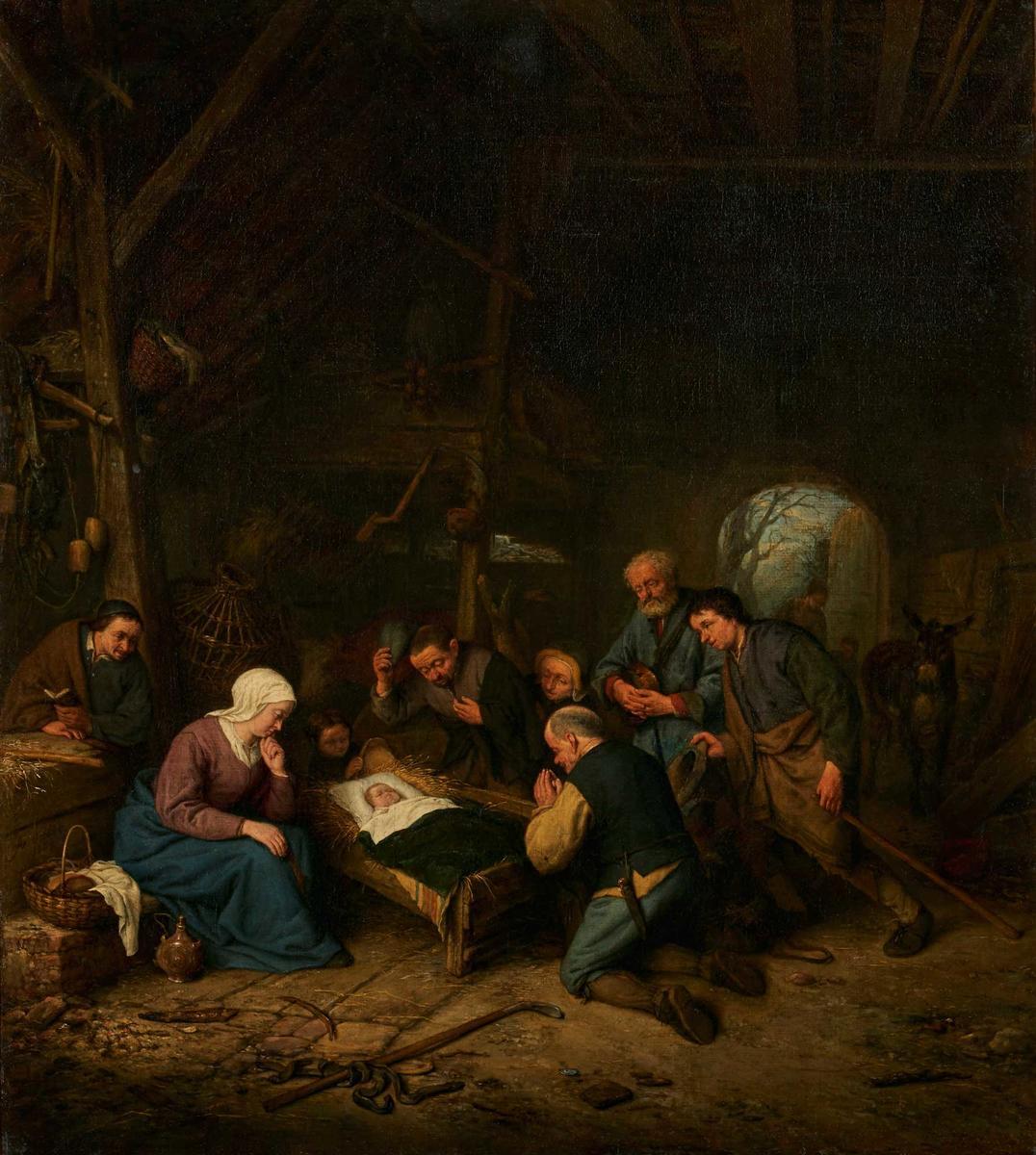
The Adoration of the Shepherds
Adriaen van Ostade (1610-1685), 1667
A Dutch painter of the Golden Age, Van Ostade specialised in genre works like village fairs, bawdy tavern scenes and scenes of humble everyday life. This, his only known nativity scene, is very finely painted, and combined with the profound emotional subtlety, produces what is considered the artist’s masterpiece. The figures here are contemplative, their features focused on the Holy Child, the muted scene is bathed in a soft light depicted with masterful use of chiaroscuro. These are ordinary people wearing the drab clothes and weariness of contemporary war-torn Haarlem.
This picture has a noteworthy provenance – purchased in the Netherlands in the 1750s by Wilhelm VIII, Grand Duke of Hesse-Kassel in Germany, it was looted by Napoleon’s army in 1806. Van Ostade’s nativity found itself among forty-eight paintings that made their way to Malmaison outside of Paris, a gift from a French General to the Empress Josephine Bonaparte. How interesting to contemplate that Napoleon and Josephine have gazed upon the same painting enjoyed at Russborough today.
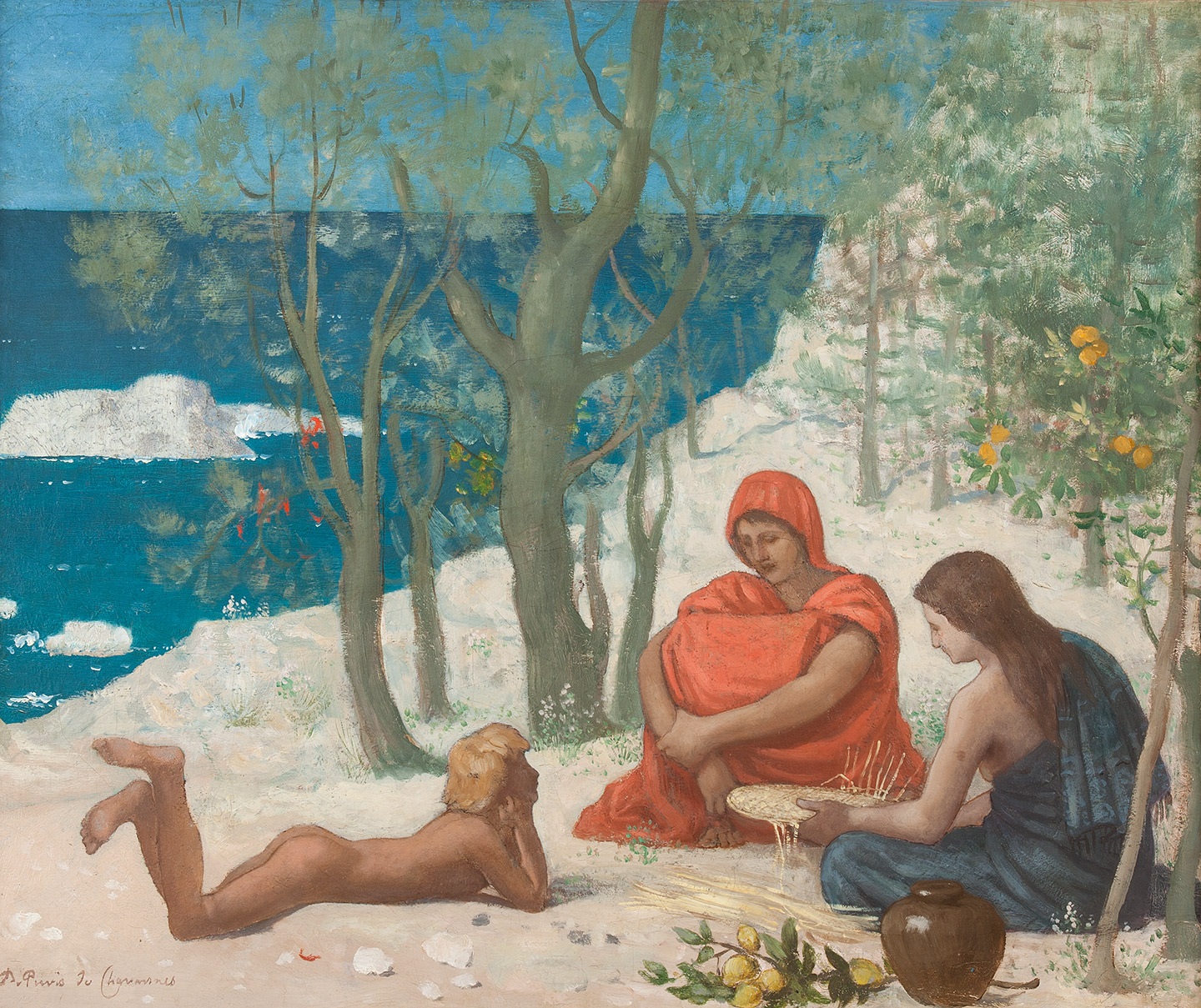
La Colonie Grecque, Marseilles
Pierre-Puvis de Chavannes (1824-1898), 1867
This painting is a study by Chavannes for a monumental mural commissioned for the Musée des Beaux-Arts de Marseille at the Palais Longchamp. The murals were to be unveiled in 1869 alongside the opening of the Suez Canal, making Marseilles the busiest port in Europe. To prepare his site-specific project, Puvis traveled to Marseilles to sketch what he saw. The peaceful vignette, modified for the foreground composition of the mural, was produced during this time.
In the 1950s Lady Clementine Beit could not take her eyes of this picture at a dinner party in the home of British publisher Sir Edward Hulton, despite having never heard of Chavannes. In 1960 Sir Alfred and Clementine spotted the painting in Marlborough Fine Art in London on a chance visit. Lady Beit later recalled: ‘Alfred said nothing. A few days later it arrived, addressed to me, a wonderful unexpected present’.
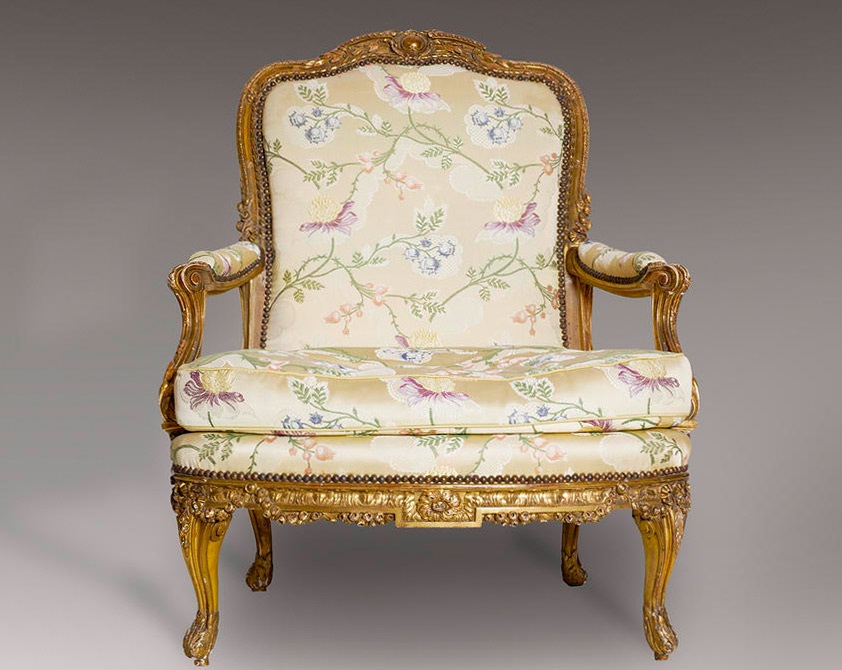
Fauteuil armchair
Nicholas Quinibert Foliot (b.1706)
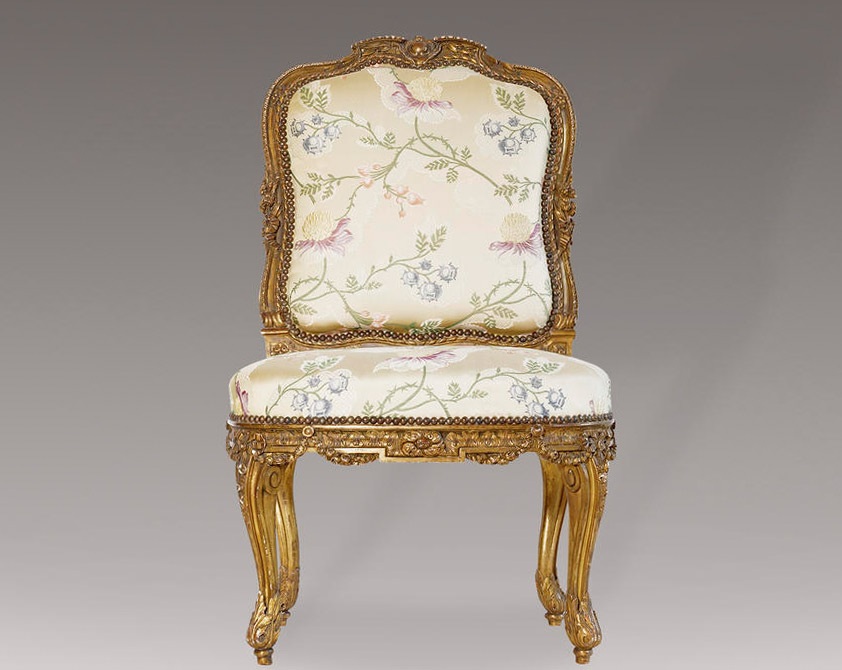
Fauteuil armchair
Nicholas Quinibert Foliot (b.1706)
One of a set of four, these regal but comfortable giltwood chairs in the entrance hall look so inviting, upholstered as they are in a pretty design of yellow Lyon silk. But alas, visitors are no longer encouraged to sit on these elegant pieces. They were made in France during the reign of King Louis XV (1715 - 1774) by Foliot, a distinguished furniture maker who created many pieces for the palaces of Versailles and Fontainebleau, earning him the title menuisier du Garde-Meuble du Roi (furniture maker to the King’s Household). There are few comparable examples to the sophisticated design and carving of this suite, rich in neoclassical and floral motifs. Seating fit for a King.
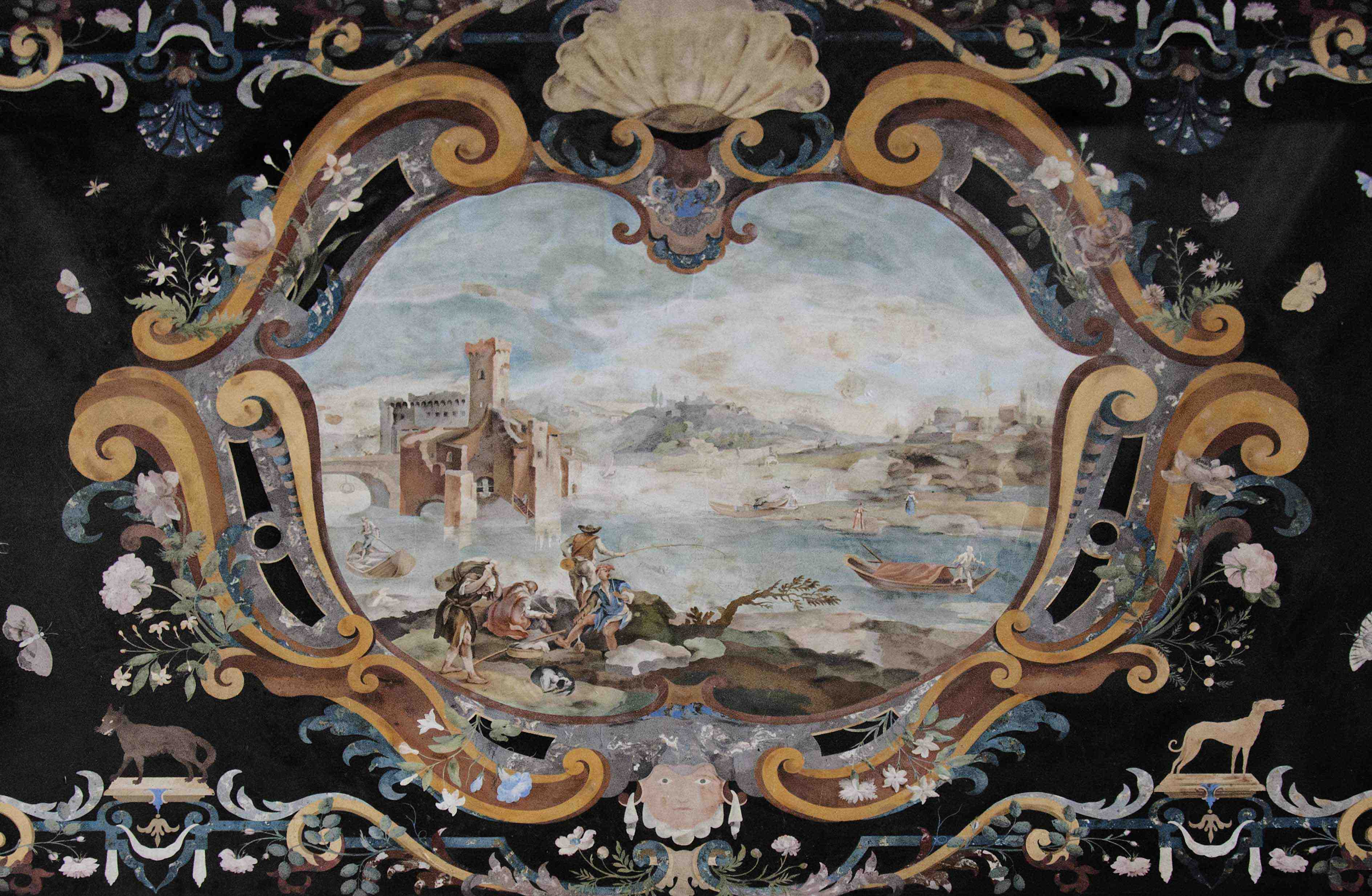
Scagliolo Table
Pietro Belloni, 1750
Pietro Belloni was a Benedictine monk of the Vallombrosa monastery near Florence. He learned his craft from his abbot, Erico Hugford, who refined the uncommon art of 'scagliolo' composition. This technique, which appears to have started in Italy in the late Renaissance time as a substitute for real marble, consisted of plaster made by pulverised selenite stone, mixed with glue and colour.
Dated 1750 this is the largest of three ordered by Joseph Leeson, later Earl of Milltown, in 1744, during his first visit to Florence. Only seven tabletops by Belloni are known to exist, all commissioned by Leeson and fellow British and Irish Grand Tourists, known to be in Italy at that time. Apparently, Pietro Belloni took a long time to finish this work but the end result was no doubt worth the wait. Recently united with its original richly carved base after more than 100 years of separation, this extraordinary piece of 18th
century furniture can be seen in the Entrance Hall.
On loan from the National Gallery of Ireland.
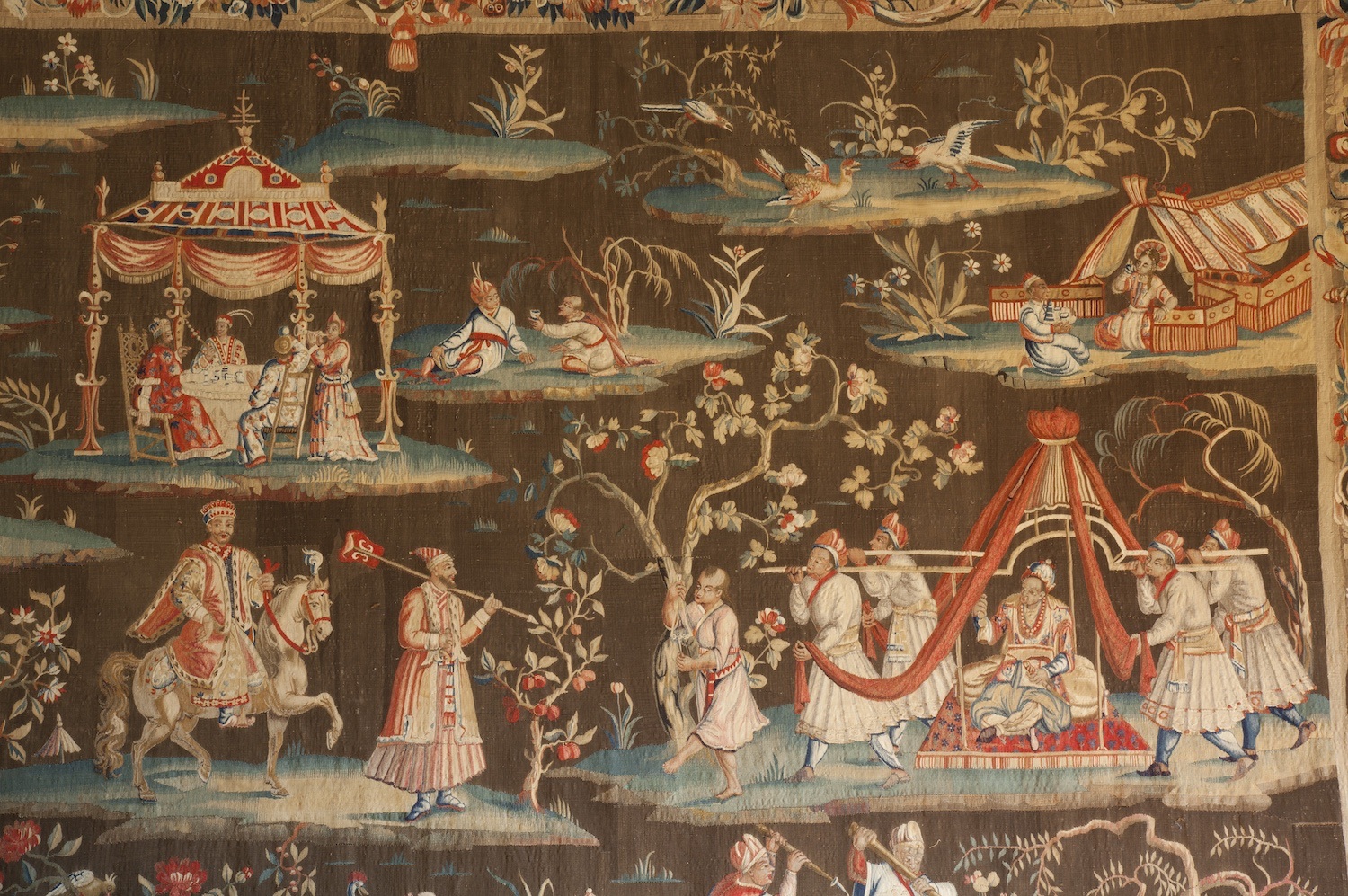
Tapestry
Attributed to John Vanderbank (fl.1682 – d.1717)
Made by French Huguenot weavers including Vanderbank in Soho, London, what have come to be known as “chinoiserie” tapestries were the height of fashion in the early 18th century. This is the smaller of a pair hanging in the Tapestry Room at Russborough.
Both feature Indo-Chinese groups, architectural features and a variety of pastimes, including tea parties, a kneeling harpist, hunting, and an emperor’s procession, on a plain brown ground. The foliate borders are enriched with flowers, trophies, quivers of arrows, batons and more. Once found in the State Bedroom of Melville House near Fife in Scotland, they were purchased by Alfred Beit in 1959 and have been right at home at Russborough ever since.
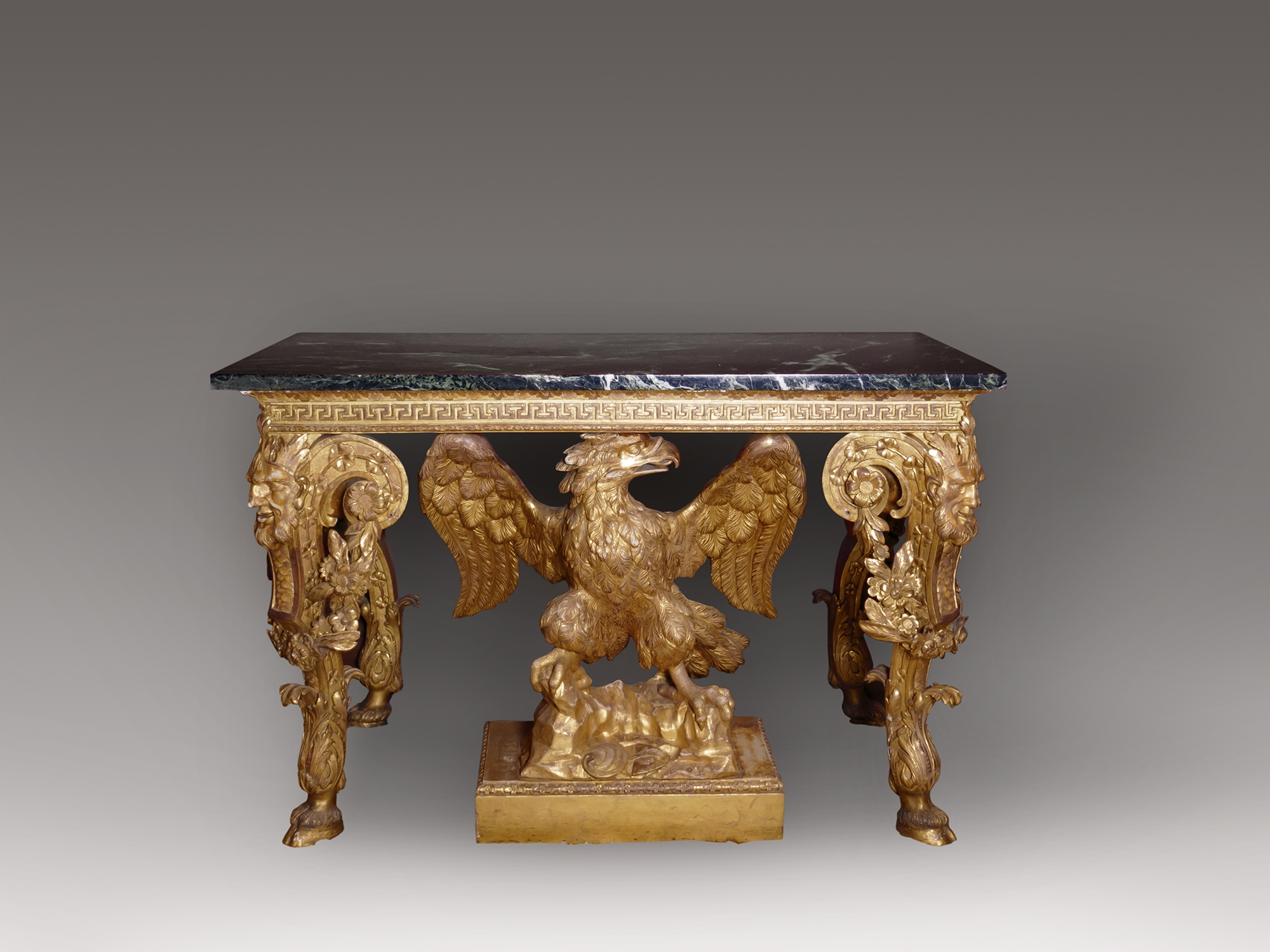
Console Table
Attributed to William Kent (1685-1748)
A pair of imposing console tables such as this can’t fail to catch your eye as soon as you enter the Dining Room at Russborough. Huge gilded eagles with outstretched wings, and legs with satyr masks and hoof feet, support dangerously heavy slabs of dark veined marble. They make a bold statement about their owner’s wealth and power.
William Kent played a pivotal role in creating a design aesthetic for 18th century Britain’s new Hanoverian Royal Family following the coronation of George I in 1714. Kent was a polymath who excelled as a painter, furniture designer, architect and landscape designer. Through royal patronage and important public commissions, he came to dominate the presentation of the new regime. The heavy, gilded style of ‘Kentian’ furniture and interiors was inspired by the Italian Baroque palaces that Kent's patrons had been taught to appreciate during their Grand Tours.
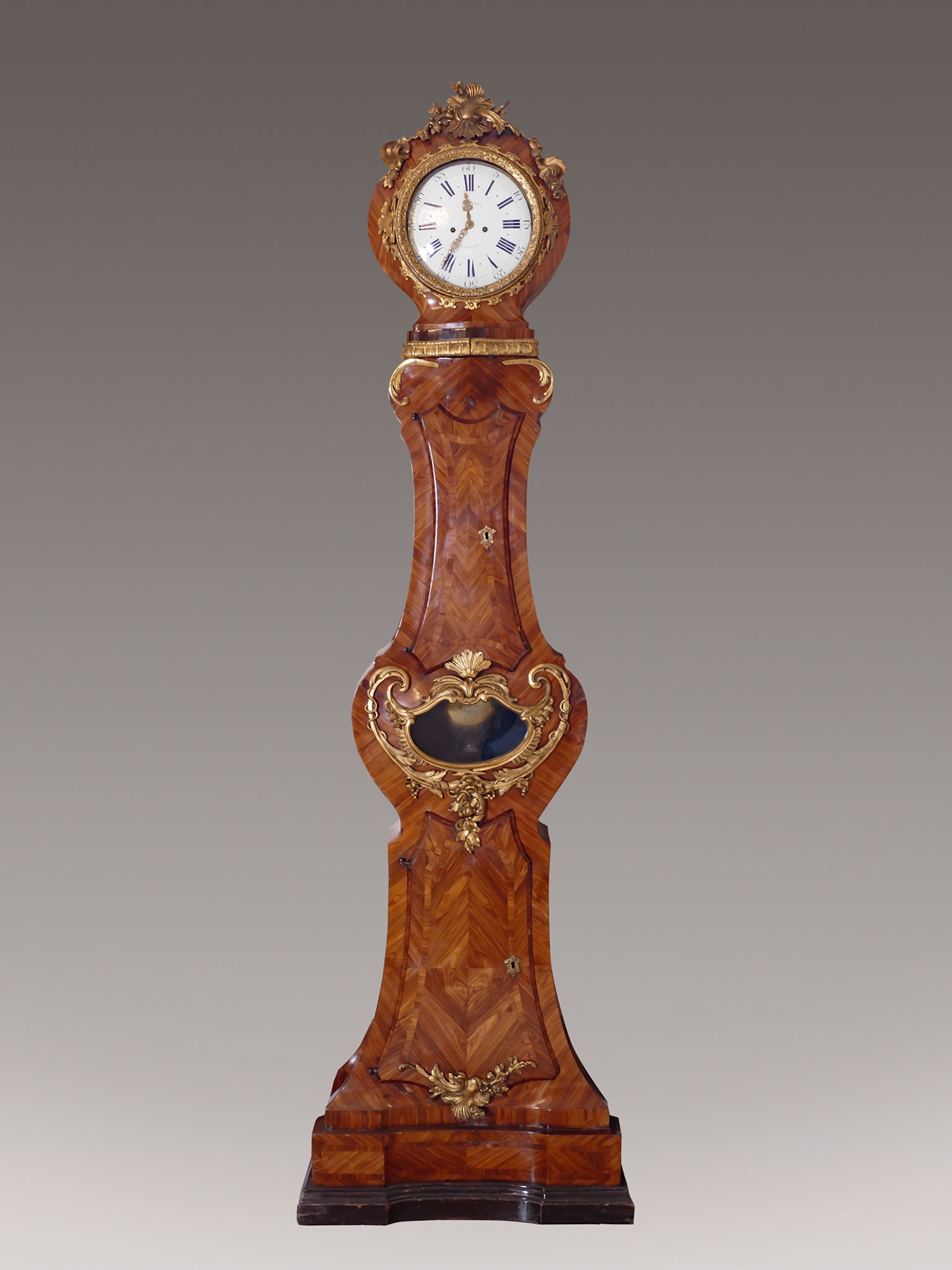
Longcase Clock
Jean Baptiste Baillon III (d.1772)
The longcase clock which stands proudly in the Entrance Hall is a timepiece that has truly stood the test of time. It was made in Paris by Jean Baptiste Baillon III in the mid-18th century. Baillon was one of the most skilled and innovative makers of his day, his almost unprecedented success leading him to become one of the most successful and influential clockmakers in Europe. His success was largely due to his ability to organise a vast and thriving private factory in Saint-Germain-en-Laye. There he crafted many beautiful pieces for a notable client list including the French and Spanish royals. A series of royal appointments culminated with his assignment as Horloger Ordinaire de la Dauphine to Marie Antoinette, Queen of France, in 1770. Time for some cake perhaps?
Here in this Rococo timepiece Baillon showcases his exquisite marquetry skills in a kingwood case richly embellished with lavish ormolu scrolls and leaf sprays. Its hourly chime continues to surprise and enchant Russborough’s visitors today.
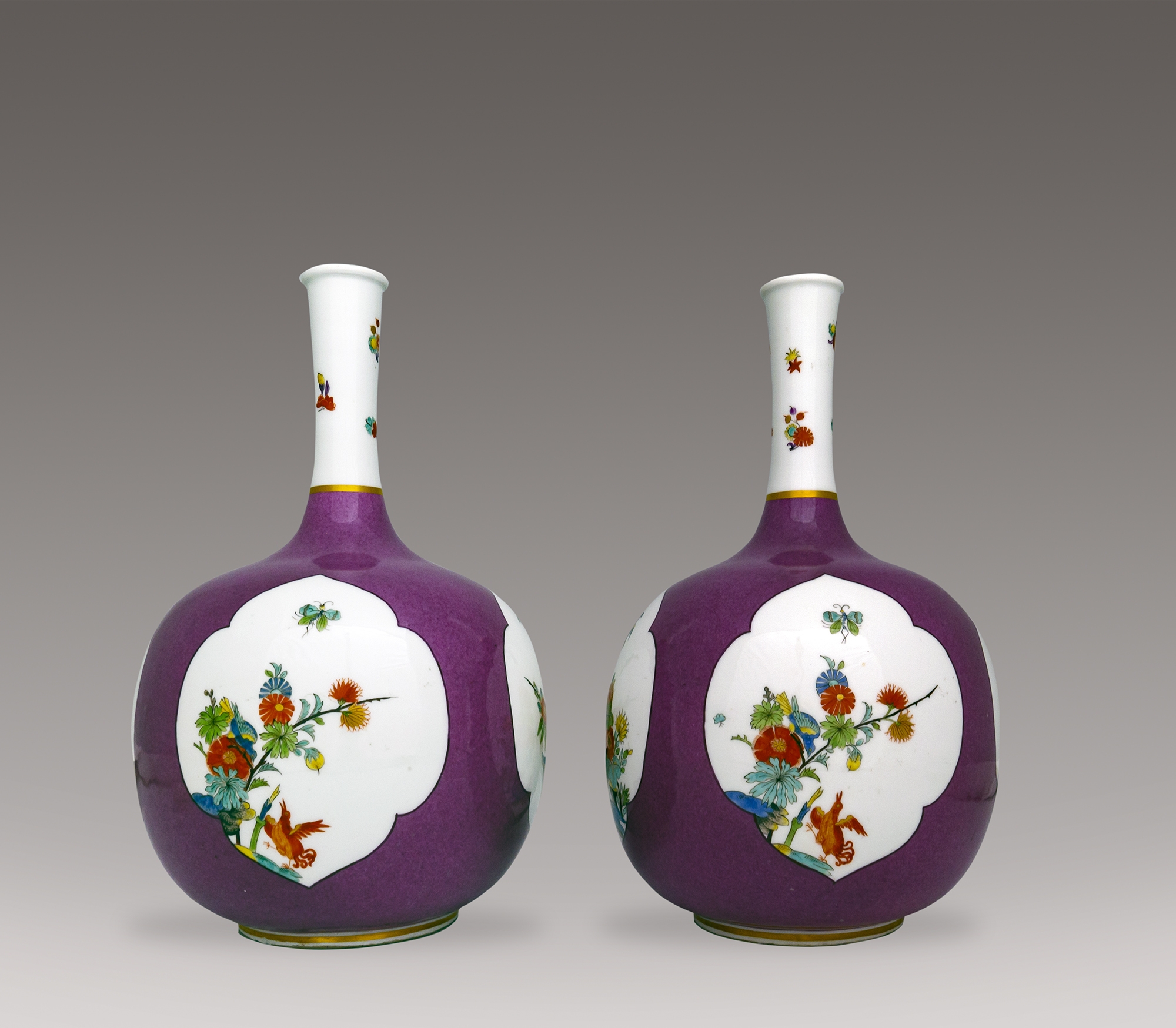
A Pair of Vases, c.1740
Meissen
Marked with the exceptionally rare Augustus Rex monogram (AR) it is believed that the vases were made c. 1740. This special mark was reserved for objects destined for the court of King August II of Poland, the founder of the Meissen factory, and later for the court of his son King August III (from 1733).
This mark is only found on early Meissen pieces decorated in either the Bottger chinoiserie style or as in this case, the kakiemon style. The vases are gourd shaped with long necks and have a powder purple ground decorated with oval shaped lozenges painted with birds and flowers against a white background.
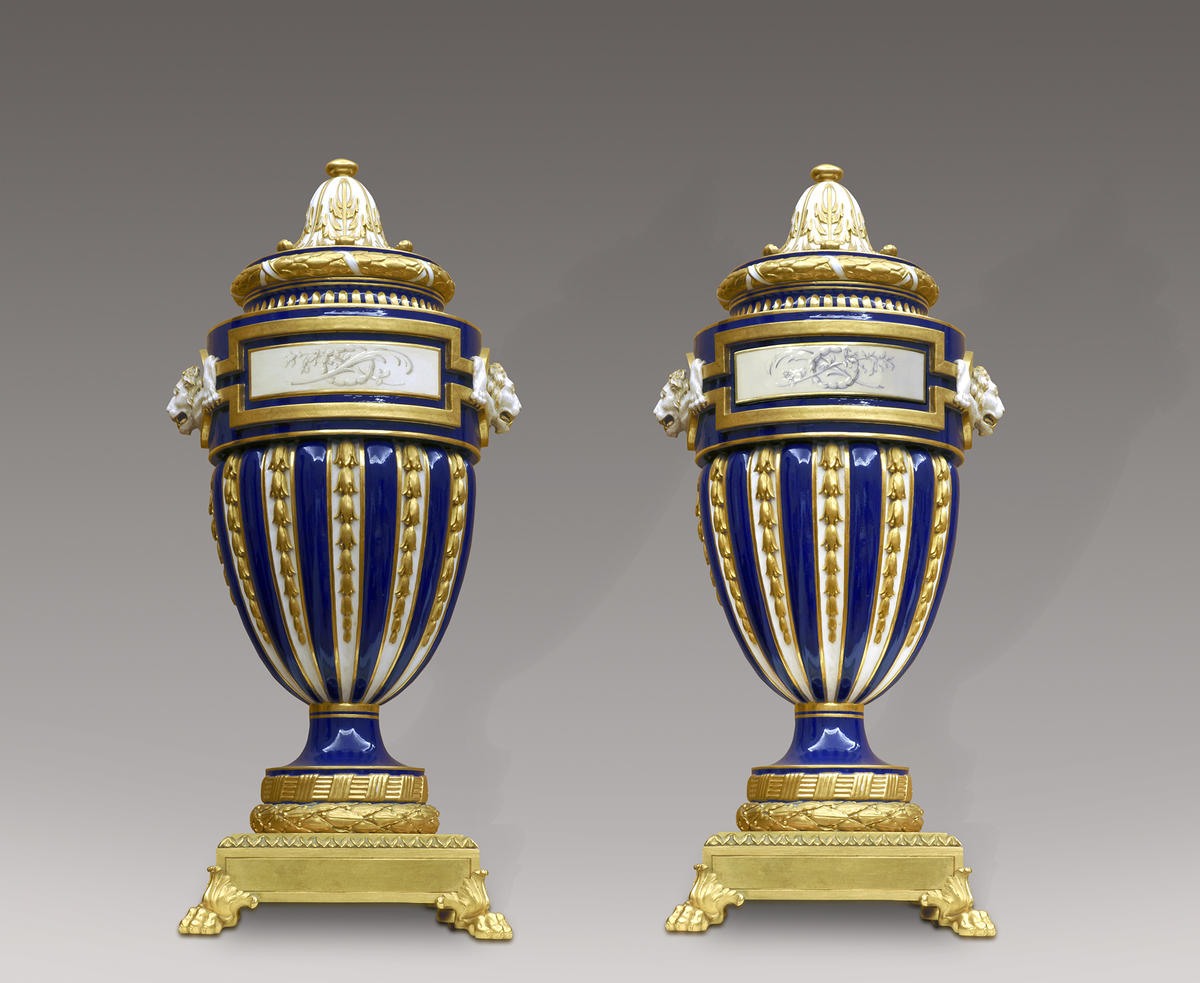
Vase à têtes de lions
Sèvres, 1772
Founded in 1740 as the Vincennes Porcelain Factory, the company moved to Sèvres, France, in 1756. As the official porcelain manufacturer to the crown, the company designed objects for use by the royal family and other aristocrats. The patronage of Madame de Pompadour, Louis XV's mistress, contributed to its success. The Sèvres Porcelain Factory has produced some of the most exquisitely designed and decorated porcelain ever made.
This pair are made of soft-paste porcelain with a rich bleu nouveau ground and feature lions’ heads and a neoclassical frieze. Embellished with gilded beading decoration they sit on gilt bronze bases. Visitors to the Blue Drawing Room at Buckingham Palace may notice that the Queen has a pair strikingly similar. The main difference is that the Russborough pair have heavier bases (culots).
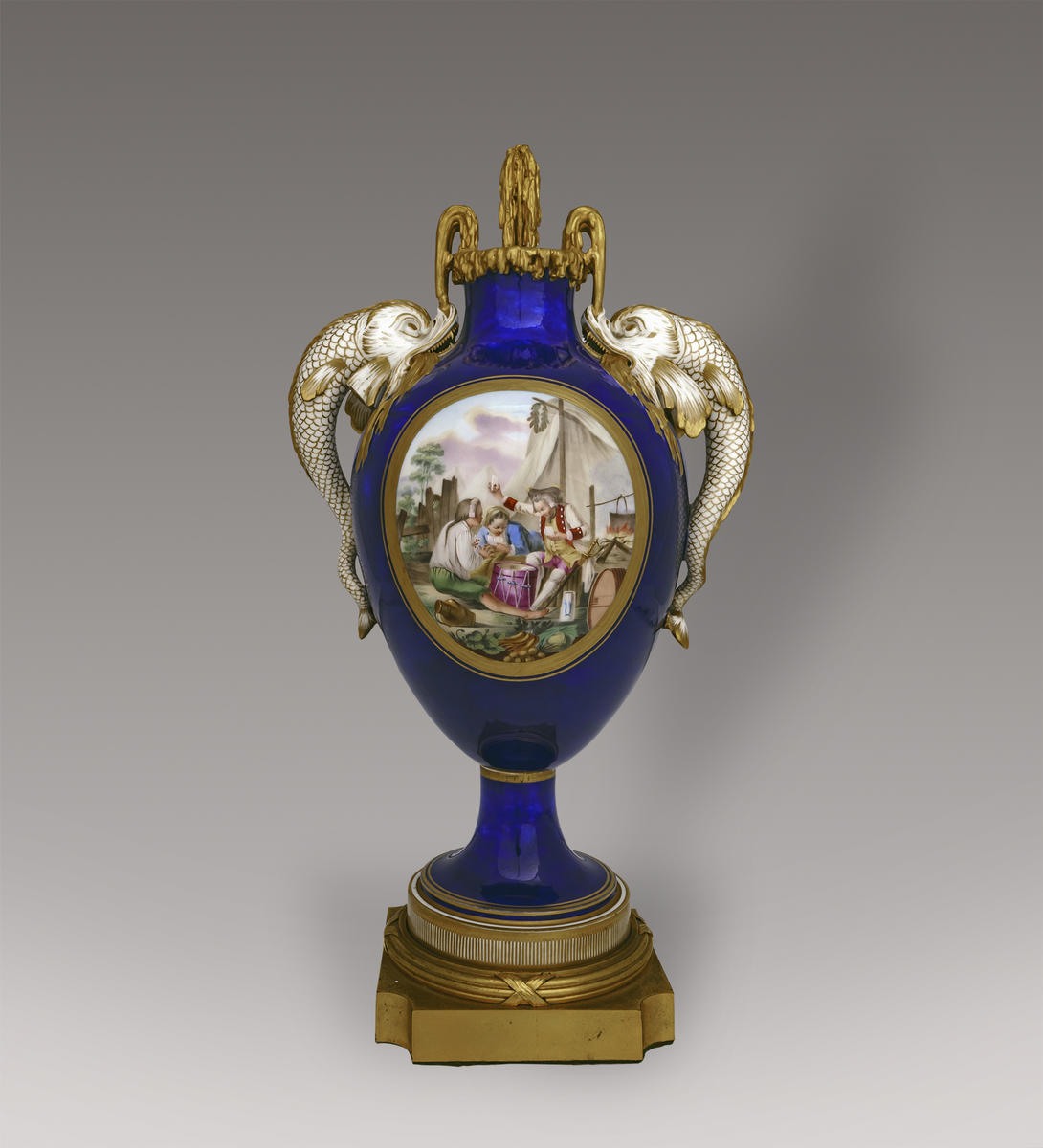
Vase à dauphins
Sèvres, c.1780
Another exquisite piece from the Sèvres Porcelain factory in Paris. The overglaze beau-bleu ground and two gilt white dolphins play in the water spouting from the gilt jet d’eau finial lid. On both sides oval reserves depict figures and military trophies painted by the artist Jean-Louis Morin (1732-1787). He specialized in figure painting during his time at Sèvres and military and marine themes feature strongly in his pieces. He liked to work from his own original sketches. Morin learned from the best, working alongside Charles Nicolas Dodin, believed to be the greatest of all the Sèvres painters.
Combining the very best of Sèvres design, modelling and painting, this vase showcases its snow-white soft-paste porcelain. Only six of this rare shape are known. Three are decorated in reserve like this, the others can be found in the Metropolitan Museum of Art in New York and the V&A in London. The remaining three feature a clock in the centre of the body (vase à pendules), including one at Sèvres, Cité de la Céramique.